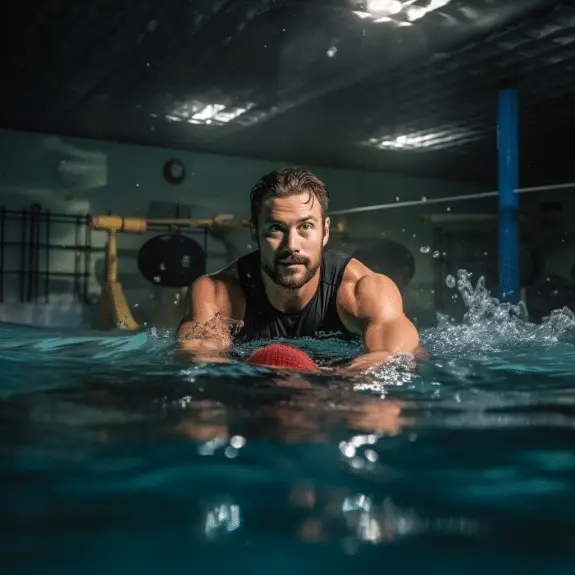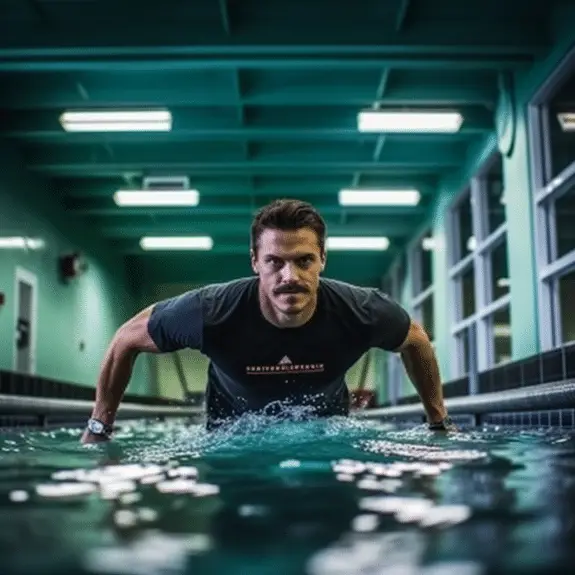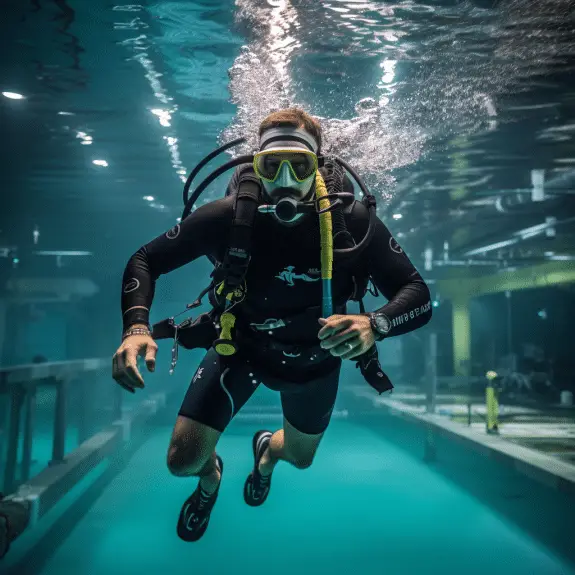Introduction
Is Swimming Strength Training: Swimming is often hailed as one of the most comprehensive and full-body workouts available, and for good reason. It engages multiple muscle groups, provides cardiovascular benefits, and enhances flexibility and endurance. But can swimming be considered a form of strength training? In this discussion, we will explore the multifaceted nature of swimming and its potential as a strength-building activity. From the resistance of the water to the dynamic movements involved, swimming transcends its reputation as a purely aerobic exercise to emerge as a viable means of developing and maintaining muscular strength. So, let’s dive into the question of whether swimming can indeed be classified as a form of strength training and explore the physical attributes it can help cultivate.
Water is denser than air, and as you move through it, your body encounters resistance. This resistance requires your muscles to work harder to propel you forward. In particular, the upper body muscles, including the shoulders, back, chest, and arms, are highly engaged in swimming to overcome water resistance.Swimming is unique in that it engages both the upper and lower body simultaneously. The kicking motion of the legs and the pulling motion of the arms work together to propel you through the water, providing a comprehensive full-body workout.
Swimming often involves sustained effort over extended periods, making it an effective means of building muscular endurance. This is particularly evident in long-distance swimming events or continuous lap swimming.To maintain proper body position and stability in the water, swimmers must rely
on their core muscles, including the abdominals and lower back. This constant engagement contributes to core strength development.

Can swimming be a strength workout?
When you swim on a regular basis, you’re doing your body all kinds of favors: you’re exercising in a variety of ways and you’re doing all them at the same time. This means you improve your cardiovascular endurance while also building muscular strength (especially in the shoulders, back and core).
Full-Body Engagement
Swimming is unique in its ability to engage multiple muscle groups simultaneously. Different strokes target various muscle sets, but all swimming styles involve the upper body (arms, shoulders, and chest), lower body (legs and core), and even your back muscles. This comprehensive engagement ensures that you’re getting a full-body strength workout.
Muscle Endurance
Endurance is an essential component of strength. Swimming builds muscle endurance as you consistently move against resistance for an extended period. This endurance development can help you perform better in other strength-training activities.
Swimming Strokes for Strength
Freestyle (Front Crawl)
Freestyle is an excellent stroke for building upper-body strength, particularly in the shoulders and arms. The continuous arm motion required to pull yourself through the water challenges these muscles, promoting muscle growth and toning.
Butterfly
The butterfly stroke is among the most demanding in terms of strength. It engages your chest, shoulders, and core extensively, offering a remarkable full-body workout that can help you develop incredible strength.
Breaststroke
Breaststroke emphasizes the legs and chest, making it an excellent choice for lower body and chest strength development. The frog-like kicking motion works the quadriceps and inner thighs, while the sweeping arm movements engage the chest muscles.
Backstroke
Backstroke targets the upper back, shoulders, and lats. The pulling motion of the arms against the water provides a unique strength-building opportunity for these muscle groups.
Is swimming as good as lifting weights?
Can you get in shape by just swimming? It depends on what your goals are. If you simply want to stay healthy and active, swimming alone can be more than enough. However, if you’re looking to build up your strength and get larger muscles, you’ll probably need to incorporate weightlifting into your workout regimen.
Low-Impact Cardiovascular Exercise
Swimming is an excellent choice if you’re looking for a low-impact cardiovascular workout. It’s gentle on the joints, making it suitable for individuals with arthritis or those recovering from injuries. Swimming can improve cardiovascular fitness, lower blood pressure, and enhance overall endurance.
Full-Body Workout
One of swimming’s key advantages is its ability to provide a full-body workout. As you move through the water, your muscles work against resistance, engaging your legs, core, back, shoulders, and arms. This comprehensive muscle engagement can help improve strength and flexibility throughout your body.
Weight Management
Swimming is an effective calorie-burning activity. Depending on the intensity and duration of your swim, you can burn a significant number of calories. It’s a great choice for those looking to manage their weight or lose excess body fat.
Low Risk of Injury
Swimming carries a lower risk of injury compared to weightlifting. The buoyancy of water reduces the impact on your joints and muscles, making it a safer option for people of all fitness levels.
What type of fitness training is swimming?
builds endurance, muscle strength and cardiovascular fitness. helps you maintain a healthy weight, healthy heart and lungs. tones muscles and builds strength. provides an all-over body workout, as nearly all of your muscles are used during swimming.
Cardiovascular Fitness
Swimming is an excellent cardiovascular exercise. It elevates your heart rate, improving your cardiovascular endurance over time.
Continuous swimming for extended periods challenges your respiratory system, increasing lung capacity and overall cardiorespiratory fitness.
Strength Training
Swimming engages a variety of muscle groups, providing a full-body workout.
Different strokes, such as freestyle, butterfly, breaststroke, and backstroke, target specific muscles, helping to build and tone them.
The resistance of water adds to the intensity, making swimming an effective strength training activity.
Endurance Training
Swimming is known for building endurance. Long-distance swimming requires sustained effort, which enhances your stamina and ability to perform well in other sports and activities.
Swimmers often incorporate interval training and drills to further improve endurance and overall performance.
Flexibility and Range of Motion
Swimming promotes flexibility, as the range of motion required for various strokes stretches the muscles and joints.
The fluid nature of swimming movements can improve joint flexibility and overall mobility.
Low-Impact Exercise
Swimming is a low-impact exercise, which means it is gentle on the joints. This makes it an excellent option for individuals with joint problems or those recovering from injuries.
The buoyancy of water reduces the risk of impact-related injuries.
Calorie Burning and Weight Management
Swimming can be an effective calorie-burning activity. Depending on the intensity and duration of your swim, you can burn a substantial number of calories.
This makes swimming a valuable component of weight management and fat loss programs.
Mental Health and Stress Relief
Swimming provides mental benefits by offering a peaceful and meditative environment. The rhythmic, repetitive nature of swimming can reduce stress and anxiety.
The sensation of being in water has a calming effect on many individuals.
Injury Rehabilitation and Cross-Training
Swimming is often used for injury rehabilitation due to its low-impact nature and ability to engage various muscle groups.
It can also be incorporated into a cross-training routine to complement other forms of exercise and promote recovery.
Competitive Sport
Swimming is not just a fitness activity but also a highly competitive sport. Competitive swimmers train rigorously to excel in events ranging from short sprints to long-distance races.
Lifelong Activity
Swimming is a lifelong fitness activity. People of all ages can enjoy and benefit from swimming, from children to seniors.
Can swimming replace resistance training?
Maintain Traditional Strength Training
Swimming is a great way to stay toned, but it shouldn’t completely replace traditional strength training.
Benefits of Swimming
Full-Body Workout: Swimming engages multiple muscle groups simultaneously, providing a comprehensive full-body workout. Different strokes target various muscles, contributing to overall muscle tone and endurance.
Low Impact: Swimming is a low-impact exercise, making it suitable for individuals with joint issues, arthritis, or those recovering from injuries. The buoyancy of water reduces stress on the joints.
Cardiovascular Fitness: Swimming is an excellent cardiovascular exercise. It elevates the heart rate, improves lung capacity, and enhances overall cardiovascular endurance.
Calorie Burning: Depending on the intensity and duration of your swim, you can burn a significant number of calories, making it a valuable component of weight management and fat loss programs.
Stress Reduction: The meditative and soothing quality of swimming can reduce stress and promote relaxation, contributing to mental well-being.
Benefits of Resistance Training
Muscle Building: Resistance training, such as weightlifting, is unmatched when it comes to building muscle mass and strength. It allows for targeted muscle development through progressive overload.
Bone Health: Lifting weights stimulates bone growth, improving bone density and reducing the risk of osteoporosis.
Metabolic Boost: Building lean muscle through resistance training increases your resting metabolic rate, helping with weight management and overall body composition.
Specific Goals: Resistance training allows you to tailor workouts to achieve specific goals, whether it’s hypertrophy (muscle growth), strength gains, or improved muscular endurance.
Versatility: Resistance training offers a wide range of exercises and equipment, providing flexibility in workout routines.
Can I build muscle by swimming?
If you’re asking yourself does swimming build muscle, then the simple answer is yes, it’s a great full-body way to build muscle.
Building Muscle through Swimming
While swimming primarily engages the cardiovascular system, it does offer some opportunities for muscle building:
Full-Body Engagement: Swimming engages a wide range of muscles throughout your body. Different strokes, such as freestyle, butterfly, breaststroke, and backstroke, target various muscle groups. The continuous resistance of water provides a unique form of resistance training.
Resistance from Water: Water is denser than air, providing resistance to your movements as you swim. This resistance challenges your muscles, promoting muscle growth and endurance over time.
Endurance Training: Swimming builds muscle endurance, which is an essential component of strength. The prolonged effort required for swimming sessions can enhance your overall stamina.
Low-Impact Nature: Swimming is a low-impact activity, reducing the risk of joint strain and injuries. This allows for consistent, long-term training, which is crucial for muscle development.
Optimizing Swimming for Muscle Building
If your goal is to build muscle through swimming, consider the following tips:
Vary Your Strokes: Incorporate various swimming strokes into your routine to target different muscle groups. Each stroke engages muscles differently, ensuring comprehensive muscle development.
Interval Training: Include interval training in your swimming sessions. Sprinting for short distances with rest intervals in between can provide an extra challenge, promoting muscle growth.
Resistance Tools: Use swimming aids like pull buoys, paddles, and fins to increase resistance and intensify your workouts. These tools can help you work specific muscle groups more effectively.
Consistency: Building muscle through swimming requires consistency. Aim for regular workouts, gradually increasing the duration and intensity of your sessions.
Nutrition and Recovery: Proper nutrition and adequate recovery are crucial for muscle growth. Ensure you consume enough protein and allow your muscles to recover between swimming sessions.
Is swimming more effective than the gym?
If you’re looking for a low-impact activity that engages multiple muscle groups, improves cardiovascular health, and promotes mental health, swimming may be a better choice for you. If you’re looking to lose fat, build muscle mass, and increase strength and power, gym workouts may be a better choice.
Cardiovascular Fitness
Swimming is an excellent cardiovascular exercise. It elevates your heart rate, improves lung capacity, and enhances overall endurance.
The rhythmic nature of swimming can help maintain steady heart rates, promoting cardiovascular health.
Full-Body Workout
Swimming engages a wide range of muscles, providing a comprehensive full-body workout. Different strokes target various muscle groups.
Water resistance adds to the workout’s intensity, promoting muscle strength and endurance.
Low-Impact Exercise
Swimming is a low-impact activity, making it ideal for individuals with joint issues, arthritis, or those recovering from injuries.
The buoyancy of water reduces stress on the joints, reducing the risk of impact-related injuries.
Stress Reduction
Swimming’s meditative qualities can reduce stress and anxiety. The soothing environment of the water promotes relaxation.
The Gym: The Land of Weights and Machines
Muscle Building
The gym, particularly resistance training with weights and machines, is unparalleled for building muscle mass and strength.
Weightlifting allows for precise targeting of specific muscle groups and progressive overload, a key factor in muscle growth.
Versatility
The gym offers a wide range of equipment and exercise options, providing flexibility in creating customized workout routines.
It’s suitable for various fitness goals, including muscle hypertrophy, strength gains, and improved muscular endurance.
Bone Health
Weight-bearing exercises in the gym, such as squats and deadlifts, promote bone density, reducing the risk of osteoporosis.
Specific Goals
Gym workouts can be tailored to meet specific fitness goals, whether it’s building a more defined physique or increasing overall strength.
Can I get ripped swimming?
If you want to get shredded, swimming is a great addition to your workout plan. When combined with a proper diet, strength training and a whole lot of consistency, swimming can help you transform your body and your health for the long haul.
Muscle Definition and Swimming
Muscle Engagement: Swimming engages multiple muscle groups, providing a full-body workout. Different strokes, such as freestyle, butterfly, breaststroke, and backstroke, target various muscle groups, contributing to muscle tone and endurance.
Calorie Burning: Swimming can burn a significant number of calories, making it beneficial for weight management and fat loss. Reducing body fat is a critical component of achieving a ripped appearance.
Low-Impact Exercise: Swimming is a low-impact activity, reducing the risk of joint strain and injuries. This allows for consistent training, which is important for overall fitness.
Challenges of Getting Ripped with Swimming
While swimming has its advantages, there are several challenges when it comes to using it as the primary means of getting ripped:
Muscle Mass: To achieve a ripped physique, you need to build and maintain significant muscle mass. Swimming primarily provides muscle endurance rather than substantial muscle hypertrophy (growth).
Caloric Intake: Swimming burns calories, but it may not create the same calorie deficit as high-intensity resistance training or intense cardiovascular workouts like running or HIIT (high-intensity interval training).
Nutritional Focus: Achieving a ripped physique often requires meticulous attention to diet, with a focus on lean protein intake, calorie control, and macronutrient balance. While swimming can support fat loss, diet plays a more crucial role in achieving a lean, defined look.
Resistance Training: Resistance training with weights or bodyweight exercises is essential for building and maintaining muscle mass while reducing body fat. Swimming alone may not provide the necessary resistance to stimulate significant muscle growth.
How many minutes swimming a day?
Start with 15 to 20 minute swims every other day, and then gradually increase to 30 minute swims five days a week, as your body allows. If you start a new swimming routine at too high an intensity, muscle soreness and fatigue could cause you to give up.
General Fitness and Health Maintenance
For general fitness and maintaining good health, swimming for 30 to 60 minutes a day is a reasonable goal. This duration allows you to engage in continuous swimming, raising your heart rate and providing cardiovascular benefits. It also provides a full-body workout that can help you stay active and healthy.
Weight Management
If your primary goal is weight management or fat loss, you may want to extend your daily swim to 45 minutes to 1 hour or more. Swimming is an effective calorie-burning exercise, and longer sessions can help you create a calorie deficit, which is essential for weight loss.
Cardiovascular Fitness
For improving cardiovascular endurance and stamina, consider swimming for 30 to 45 minutes a day, incorporating interval training and swim drills to challenge your heart and lungs. This approach can enhance your cardiovascular fitness over time.
Muscle Building
While swimming primarily focuses on muscle endurance, you can build muscle with longer and more intense swimming sessions. If muscle building is your goal, aim for 45 minutes to 1 hour of swimming each day, incorporating various strokes and resistance tools like paddles and fins.
Rehabilitation and Recovery
If you’re using swimming for injury rehabilitation or as a low-impact recovery activity, 20 to 30 minutes of gentle swimming can be sufficient. Swimming’s buoyancy and low-impact nature make it suitable for recovery purposes.
Skill Improvement
If you’re a competitive swimmer or looking to improve your swimming technique, daily practice sessions of 30 to 60 minutes or more may be necessary. These sessions should focus on stroke refinement, drills, and specific skill development.

Conclusion
Swimming can undoubtedly be considered a form of strength training. It offers a multifaceted approach to building and toning muscles throughout the body, engaging both the upper and lower body simultaneously. The resistance provided by the water challenges muscles, making them work harder to propel the swimmer forward. This dynamic resistance, combined with the sustained effort required for swimming, promotes muscular endurance and functional strength.
Swimming’s full-body engagement goes beyond traditional strength training, contributing to the development of core strength, balance, and coordination. Moreover, its low-impact nature makes it accessible to a wide range of individuals, including those with joint issues, while still delivering a challenging workout.
While swimming may not be the primary choice for those seeking maximal strength gains or significant muscle hypertrophy, it excels in providing a well-rounded approach to strength training, cardiovascular fitness, and overall physical health. Whether you’re a dedicated swimmer or someone looking to diversify your fitness routine, swimming offers a unique and effective way to build strength, improve endurance, and enhance overall well-being. So, jump in and embrace the benefits of swimming as a form of strength training.

